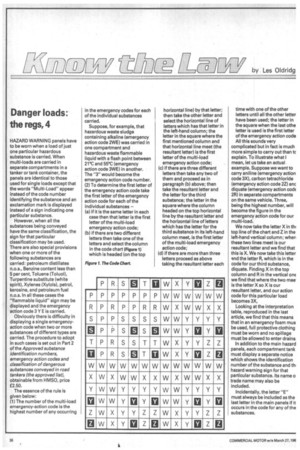Danger loads: the regs, 4
Page 28

If you've noticed an error in this article please click here to report it so we can fix it.
HAZARD WARNING panels have to be worn when a load of just one particular hazardous substance is carried. When multi-loads are carried in separate compartments in a tanker or tank container, the panels are identical to those used for single loads except that the words "Multi-Load" appear instead of the code number identifying the substance and an exclamation mark is displayed instead of a sign indicating one particular substance.
However, when all the substances being conveyed have the same classification, the sign for that particular classification may be used. There are also special provisions when one or more of the following substances are carried: petroleum distillates n.o.s., Benzine content less than 5 per cent, Toluene (Toluol), Turpentine substitute (white spirit), Xylenes (Xylols), petrol, kerosine, and petroleum fuel n.o.s. In all these cases the "flammable liquid" sign may be displayed and the emergency action code 3 YE is carried.
Obviously there is difficulty in displaying a single emergencyaction code when two or more substances of different types are carried. The procedure to adopt in such cases is set out in Part 2 of the Approved substance identification numbers, emergency action codes and classification of dangerous substances conveyed in road tankers (the approved list), obtainable from HMSO, price £2.50, The essence of the rule is given below: (1) The number of the multi-load emergency-action code is the highest number of any occurring in the emergency codes for each of the individual substances carried.
Suppose, for example, that hazardous waste sludge containing alkaline (emergency action code 2WE) was carried in one compartment and hazardous waste flammable liquid with a flash point between 21°C and 55°C (emergency action code 3WE) in another. The "3" would become the emergency action code number. (2) To determine the first letter of the emergency action code take the first letter of the emergency action code for each of the individual substances — (a) if it is the same letter in each case then that letter is the first letter of the multi-load emergency action code; (b) if there are two different letters then take one of the letters and select the column in the code chart (Figure 1) which is headed (on the top horizontal line) by that letter; then take the other letter and select the horizontal line of letters which has that letter in the left-hand column; the letter in the square where the first mentioned column and that horizontal line meet (the resultant letter) is the first letter of the multi-load emergency action code; (c) if there are three different letters then take any two of them and proceed as in paragraph (b) above; then take the resultant letter and the letter for the third substance; the letter in the square where the column headed on the top horizontal line by the resultant letter and the horizontal line of letters which has the letter for the third substance in its left-hand column meet, is the first letter of the multi-load emergency action code; (d) if there are more than three letters proceed as above taking the resultant letter each time with one of the other letters until all the other letter have been used; the letter in the square when the last othe letter is used is the first letter of the emergency action code All this sounds very complicated but in fact is much more simple to carry out than tc explain. To illustrate what I mean, let us take an actual example. Suppose we want to carry aniline (emergency action code 3X), carbon tetrachloride (emergency action code 2Z) anc diquate (emergency action codE 2R) in separate compartments on the same vehicle. Three, being the highest number, will become the figure in the emergency action code for our multi-load.
We now take the letter X in thi top line of the chart and Z in the left-hand vertical column; when these two lines meet is our resultant letter and we find that this is X. We now take this letter and the letter R, which is in the code for our third substance, diquate. Finding X in the top column and R in the vertical on€ we find that where the two mee. is the letter X so X is our resultant letter, and our action code for this particular load becomes 3X,
Looking at the interpretation table, reproduced in the last article, we find that this means that in an emergency foam mus be used, full protective clothing must be worn and no spillage must be allowed to enter drains.
In addition to the main hazard panels, each compartment tank must display a separate notice which shows the identification number of the substance and thi hazard warning sign for that particular substance. Its name o trade name may also be included.
Incidentally, the letter "E" must always be included as the last letter in the main panels if it occurs in the code for any of the substances.


















































